The parish of Harpham is situated in what was once the wapentake of Dickering, part of the historical East Riding of Yorkshire (see maps in Introduction). Before the Norman Conquest it was owned partly by three larger manors, the main one being Burton Agnes. It passed briefly under the administration of Buckrose in 1937, then to the Bridlington registration district, and since 2002 has been a civil parish of the East Riding which includes the hamlets of Lowthorpe and Ruston Parva.
In 1066 the tenants-in-chief were Earl Morcar and Ernwin the priest, but by 1086 Harpham had been laid waste and William the Conqueror had taken over what was left of Morcar’s share. Ernwin’s estate later passed to Robert de Brus, who seems to have acquired the Crown estate too. In the 12th century Roger de Stuteville held Harpham of the fee of Adam de Brus, but by the end of that century it was in the hands of his sister and co-heir Agnes, the wife of Herbert de St. Quintin. Harpham was to be held by the St. Quintin family until the late 17th century, and it was their chief seat until it was supplanted by Scampston. On the death of Sir William St. Quintin, unmarried, in 1795 Harpham was was inherited by his nephew, the son of his sister Mary, William Thomas Darby, who assumed his uncle’s surname. It remained in the family until the death in 1943 of Violet Helen Duncombe, widow of William Herbert St. Quintin. Their granddaughter brought part of the Harpham estate and Scampston by marriage to the Legard family and they remain in the hands of that family today.
A manor house is known to have existed adjacent to the church. Earthworks reveal a large enclosure which contained the house together with a number of manorial buildings. It is partly defined by a broad bank to the north and west and partly by a moat to the south. The eastern side is obscured by Manor Farm and the north eastern corner is occupied by the St John’s church. The manor house was not assessed for hearth tax in 1670, so it is believed to have already been demolished by then. This coincides with family’s move to Scampston.
Within the enclosure is what has become known as the drummer boy’s well. Legend has it that William the Conqueror promised the land of Harpham to the first of his men to enter the village. This happened to be the drummer boy, followed closely by a St. Quintin, who killed the boy and threw his body down the well in order to claim the land for himself. Since that time the sound of a beating drum has been heard coming from the well whenever the head of the St. Quintin family is about to die.
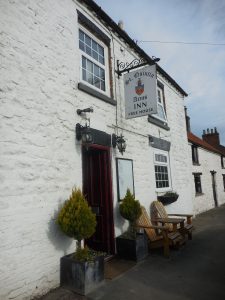 | 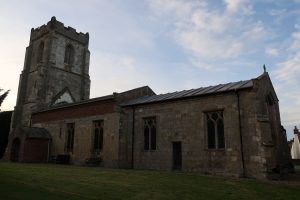 left: St. Quintin Arms inn, 2017 | 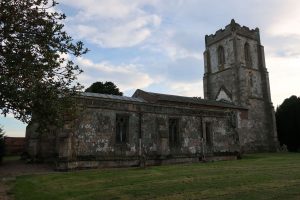 right: Drummer boy's well, 2017 | 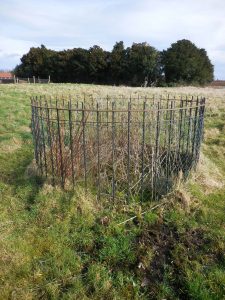 |
The church at Harpham is dedicated to St. John of Beverley and is of some antiquity with its 12th century nave, its early 14th century chancel (rebuilt in 1827) and its late 14 century west tower. It was first mentioned in 1100-1115, when it was given to St. Mary’s Abbey in York, one of the wealthiest Benedictine foundations in Europe. On the north side of the nave is a small aisle, which became the the burial place of the St. Quintin family, with memorials fixed to the walls and floor, and with the family arms and pedigree displayed in the stained glass windows, making Harpham ever associated with the St. Quintins.
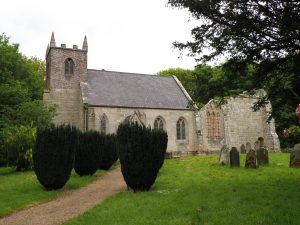
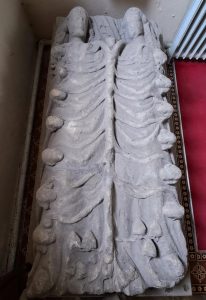
© C.S. Hall, 2024
Lowthorpe was made up of three estates in 1066, one belonging to the archbishop of York and the others to Ecgfrith and Asa. Following the Conquest the latter two were taken over by the Crown, and in the 12th century they passed into the tenancy of the family that took its name from the village. By the end of the century they had passed by the marriage of two Lowthorpe heiresses to two men of the Heslerthorpe family. Both estates were granted to Lowthorpe college in the late 14th century until its Dissolution in 1548, when they passed through many hands until they were sold to Sir William Quintin in 1720, after which they followed the descent of Harpham. The archbishop of York’s estate also eventually came in the hands of Sir William. The St. Quintons had a manor house which was demolished in 1826 and Lowthorpe Lodge built in its place.
The church at Lowthorpe is dedicated to St. Martin, in which Sir John Heslerton instituted a college served by a rector and six chantry priests in 1333. In 1364 Sir Thomas Heslerton added another chantry for the souls of himself and his wife. The building consists of a nave, chancel and west tower, but the chancel has long been roofless, reportedly since Georgian times, and the table tombs and grave slabs contained within it are gradually crumbling away. The remainder of the church, which is still in use today, contains an intriguing tomb of a couple. The pair are said to be Sir John Heslerton and his wife lying beneath a sheet from which emerges a tree, the branches of which terminate in the carved heads of their thirteen children, arranged around the edge of the tomb.
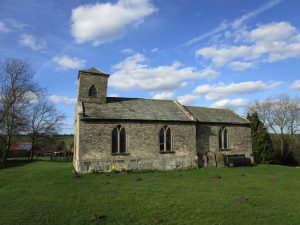
Ruston Parva had two estates in 1066, owned by the archbishop of York and Ecgfrith. The archbishop retained his estate until the Dissolution, after which it passed through various hands, before being acquired by Sir William St. Quintin. Ecgfrith’s estate was taken over by the William the Conqueror in 1086, but by the 13th century it formed part of the fee of the Percy family who let it to various tenants over the following centuries. Each estate had a manor house. All that remains of the archbishop’s house is a drawing of a two storey building dated c1720, while traces of a moat discovered in 1968 near the church are thought to belong to Upper House, the Crown’s manor. The original church of All Saints stood on a hill in the south of the village, but was demolished and replaced in 1832 by a new one re-erected in the Norman style. It is a Grade II* listed building, now dedicated to St. Nicholas. Its tower is supported by cast iron pillars but still manages to lean backwards, though the font still stands proudly upright in the chancel.
Richard Puckering, a shepherd born in Elmswell, married his bride, Jane Collinson of Boynton, in Harpham church in 1831 (see Puckerings of Driffield, 13th generation). The family home was in Little Driffield and, though Richard’s profession meant that he was often absent, the couple had fourteen children, only three less than their son William and his wife Frances Elliott! It is not surprising that many members of this prolific family emigrated to Canada and Australia.
William Pickering and Elizabeth Ouston, whose son William was born in Ruston Parva in 1785, were probably the great grandparents of Christopher Godmond Pickering, fish merchant, ship owner and well-known benefactor to the people and city of Hull (see Pickerings of Driffield, 3rd generation). Pickering life events also took place in Lowthorpe, but I have not been able to attach the individuals to an established family.
Sources:
Harpham:
https://www.genuki.org.uk/big/eng/YKS/ERY/Harpham
https://en.wikipedia.org/wiki/Harpham
https://opendomesday.org/place/TA0961/harpham
Victoria History of the County of York, East Riding, vol. 2, p. 224-5 (not online)
Early Yorkshire Charters, The Stuteville Fee, vol. 9, p. 28 (not online)
History and Topography of Yorkshire, vol. 2, York, Ainsty, East Riding, p. 477: https://books.google.fr/books?redir_esc=y&id=unEKAQAAMAAJ
Harpham Manor: http://www.gatehouse-gazetteer.info/English%20sites/4839.html
Church of St. John of Beverley: https://historicengland.org.uk/listing/the-list/list-entry/1083345?section=official-list-entry
Church of St. John of Beverley, Harpham: http://www.gatehouse-gazetteer.info/English%20sites/4231.html
Lowthorpe:
https://www.genuki.org.uk/big/eng/YKS/ERY/Lowthorpe
https://en.wikipedia.org/wiki/Lowthorpe
https://opendomesday.org/place/TA0760/lowthorpe
Victoria History of the County of York, East Riding, vol. 2, pp. 272-4 (not online)
History and Topography of Yorkshire, vol. 2, York, Ainsty, East Riding, p. 484: https://books.google.fr/books?redir_esc=y&id=unEKAQAAMAAJ
Church of St. Martin: https://historicengland.org.uk/listing/the-list/list-entry/1346656?section=official-list-entry
Lowthorpe Church: https://www.britainexpress.com/attractions.htm?attraction=4591
Ruston Parva:
https://www.genuki.org.uk/big/eng/YKS/ERY/RustonParva
https://en.wikipedia.org/wiki/Ruston_Parva
https://opendomesday.org/place/TA0661/ruston-parva
Victoria History of the County of York, East Riding, vol. 2, pp. 321-2 (not online)
History and Topography of Yorkshire, vol. 2, York, Ainsty, East Riding, p.489: https://books.google.fr/books?redir_esc=y&id=unEKAQAAMAAJ
Monument Number 910832: https://www.heritagegateway.org.uk/Gateway/Results_Single.aspx?uid=910832&resourceID=19191
Church of St. Nicholas: https://historicengland.org.uk/listing/the-list/list-entry/1083348?section=official-list-entry
